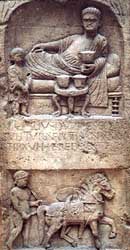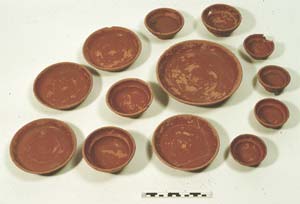
Click on the image for a larger version.
|
Image
details:
Depiction of feasting was a common motif
in Roman funerary art. The diner is represented reclining
on a couch, with other furniture and dining gear. This is
the tombstone of auxiliary cavalryman M. Aemilius Durises
from Bonn, Germany
Image ownership:
Vroma, Photo Barbara McManus, Bonn,
Rheinisches Landesmuseum. |
In its diet the army was a privileged group in Roman society, since
it was in the emperors' and generals' self-interest to ensure that
soldiers were properly fed. The supply of common elements to garrisons
across the Roman world, especially wine and olive oil, wherever
units were stationed is not unlike the way modern armies provide
familiar foods for their soldiers when posted abroad. A wide range
of foodstuffs is attested among the tablets, including cereals,
meat from farmed and wild animals, drink, fruit and vegetables,
herbs and spices. Cereals the staple food, are well attested in
the tablets. The wheat was used for bread (panis) and perhaps
also for puls, a type of porridge. Barley fed the animals,
but soldiers also ate it when wheat was unavailable or when they
were on punishment rations. The importance of preserved pig meat
is well illustrated by many references to bacon, ham and lard. There
is evidence too of the 'Mediterranean' element of the diet, especially
wine, olive oil and fish sauce, an element reflected also in the
finds of amphorae, especially
oil amphorae from southern Spain, on the site. The units stationed
at Vindolanda may have brought their taste for beer with them from
their homeland, still famous for its brewing. The tablets must also
be supplemented by archaeological evidence. For example the remains
of cows and sheep predominate in the animal bones recovered from
the site, but their consumption is not recorded in the tablets.
Since many of the documents derive from the prefect's household,
the diet may be not entirely typical of the whole garrison. However
the limited information on other ranks however suggests that they
too had access to luxuries. Despite its expense, reflecting its
long journey to northern Britain from Asia, pepper was bought by
a solider who seems to be of low rank.
A table with some references to food.
| Term |
Translation |
References |
| Acetum |
Sour wine |
190 |
| Axungia
|
Pork fat |
190 |
| Bracis |
Cereal |
191 |
| Cervesa
|
Beer |
190 |
| Cervina
|
Venison |
191 |
| Condimenta
|
Spices |
191 |
| Faba |
Beans |
192,
302 |
| Frumentum
|
Wheat |
185,
191 |
| Hordeum
|
Barley |
185,
190 |
| Malum |
Apples |
302 |
| Muria |
Fish sauce |
190,
302 |
| Oleum |
Oil |
203 |
| Olivae |
Olives |
302 |
| Ostria |
Oysters |
299 |
| Ova |
Eggs |
302 |
| Perna |
Ham |
191 |
| Piper |
Pepper |
184 |
| Pullus |
Chicken |
302 |
| Sal |
Salt |
185 |
| Vinum |
Wine |
190,
203 |
|

Click on the image for a larger version.
|
Image
details:
A set of samian vessels, perhaps a ëdining serviceí, imported from southern Gaul, supplied as grave goods in a late first century AD burial from St Albans.
Image ownership:
© St Albans Museums
|
Dining utensils are mentioned in the tablets and occur in the archaeological
assemblage. 194
lists what might be a service of dining and drinking vessels, including
scutulae ('shallow dishes'), paropsides ('side-plates'),
acetabula ('vinegar-bowls'), ouaria ('egg-cups'),
calices ('cups') and trullae ('bowls'). Linking the
terms to archaeologically known vessel types is not possible, but
the suggested translations capture the range and complexity of vessel
types required for Roman style dining. These dishes would have been
of pottery, glass or bronze, all attested archaeologically at Vindolanda,
or even of silver. Correct dinner dress was also required. 196
records a long list of different types of clothing including cloaks
and tunics, some of which are specifically identified as appropriate
for dining. Life in the army, especially for the garrison commander,
could be as much a matter of manners as
of military tactics.
Tablet database link: Browse all tablets that mention foodstuffs.
|